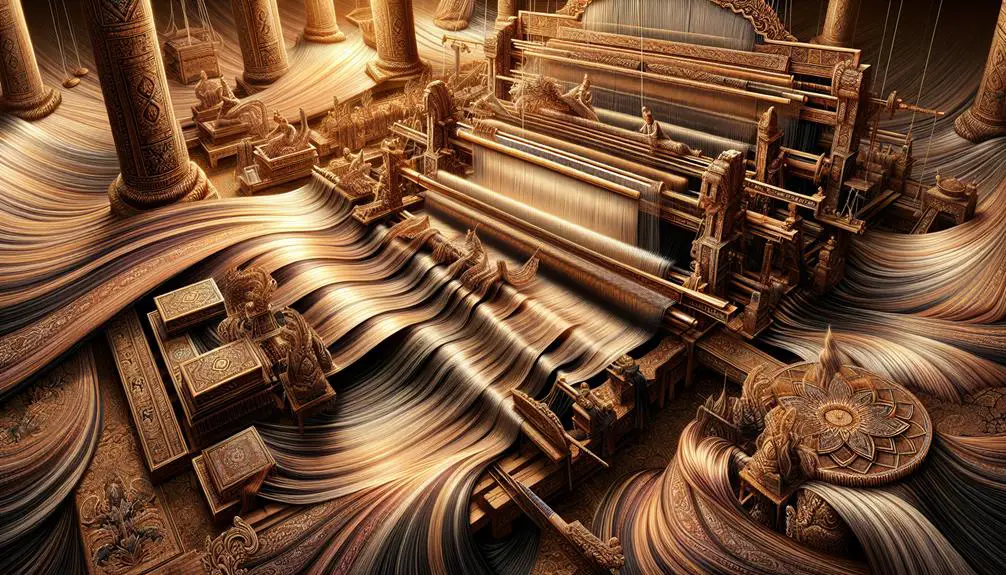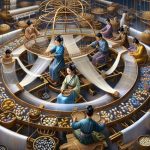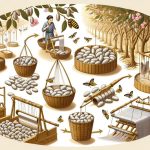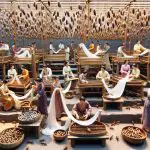Silk is expensive because it requires a labor-intensive production process. Skilled artisans delicately harvest cocoons to create this exquisite fabric. The limited geographic availability of silkworms, mainly in China and India, adds to the exclusivity and cost. The high demand for silk, along with its reputation for sophistication, also contributes to its price. With exceptional quality, durability, and being a symbol of luxury, silk maintains its high market value. The intricate processes involved in silk production and its historical significance further elucidate why silk is a prized commodity. Its rich cultural significance and modern production techniques shape this luxurious fabric.
Table of Contents
Key Takeaways
- Labor-intensive production process requiring skilled artisans.
- Limited geographic production mainly in China and India.
- High demand, exclusivity, and prestige elevate prices.
- Delicate and time-consuming harvesting of silk cocoons.
- Quality, durability, and craftsmanship contribute to high costs.
Labor-Intensive Silk Production Process
Silk production demands meticulous attention and skilled labor due to its labor-intensive process from raising silkworms to harvesting delicate cocoons. Every step in the production of high-quality silk requires precision and expertise. The journey begins with carefully nurturing silkworms, providing them with the ideal conditions to thrive and produce fine silk fibers. Handling these delicate fibers with care is essential to maintaining the integrity and quality of the silk.
Harvesting silk from cocoons is a delicate task that requires patience and skill. Each cocoon must be carefully unraveled to retrieve the silk threads within. It can be surprising to learn that it takes up to 40 cocoons to produce just one yard of silk fabric. This illustrates the level of effort and dedication that goes into creating high-quality silk products.
The labor-intensive nature of silk production contributes to the high cost of this luxurious fabric. Skilled artisans work tirelessly to make sure that every piece of silk meets the standards of quality and durability expected from such a prestigious material.
Limited Availability of Silk
Silk's scarcity is closely tied to the limited availability of silkworms, mainly found in regions like China and India.
The labor-intensive process of extracting silk from cocoons further restricts its supply.
Factors like climate conditions and disease outbreaks can also impact the availability of silkworms, contributing to the exclusivity of silk.
High Production Costs
Why are the production costs of silk so high, leading to its limited availability in the market?
Silk's high production costs stem from the intricate process of harvesting silkworm cocoons. This labor-intensive method requires specialized skills and knowledge, adding to overall expenses. The exclusivity and superior quality of silk fibers also elevate production costs, making silk a luxury item.
Moreover, the limited availability of silk contributes to its high market price, as demand often exceeds the supply. The high demand for silk products further boosts its perceived value, creating a cycle of elevated prices.
These factors combined make silk production a costly endeavor, resulting in its limited availability and premium pricing in the market.
Labor-Intensive Production Process
Engaging in the intricate process of silk production involves meticulous cultivation of silkworms and delicate handling of their cocoons, requiring skilled labor and specialized expertise.
Within the silk industry, every step from harvesting raw silk to weaving intricate fabrics demands careful attention to detail.
The limited availability of silk stems from its natural sourcing from silkworm cocoons, contributing to its exclusivity and higher cost.
The expertise of artisans in cocoon selection, reeling, and weaving is essential for maintaining the quality and finesse associated with silk.
This specialized knowledge not only adds to the production costs but also guarantees that each piece of silk fabric meets the high standards expected in the market.
Importance of Skill in Silk Making
Skill plays an essential role in every aspect of silk making, ensuring the quality and integrity of the final product. When it comes to silk production, skilled labor is indispensable for handling silkworm colonies, overseeing cocoon weaving, and maintaining the health of the silkworms. The expertise of artisans is pivotal in preventing diseases that could affect the silkworms during the farming process.
Additionally, the intricate nature of silk making demands specialized knowledge and precision to create high-quality silk fabrics. Furthermore, handling the delicate silk strands during the harvesting process requires skilled labor to guarantee the fabric's integrity is preserved. The labor-intensive nature of silk production underscores the significance of skill at every stage of the process, highlighting the craftsmanship and dedication required to produce this luxurious textile.
Exclusivity and High Demand
So, let's talk about why silk is so sought after and expensive.
The rarity of silk, driven by its limited supply from silkworm cocoons, plays a significant role in its high price tag.
People desire silk not just for its quality but also for the luxurious status it carries as a symbol of sophistication and refinement.
Rarity Drives Prices
Rarity plays a significant role in driving the prices of silk, fueled by its exclusivity and high demand in the market. The scarcity of mulberry, which is essential for the production of silk, contributes to its limited availability and premium pricing. The high demand for silk surpasses its supply, creating market fluctuations and substantial price variations. Factors like climate conditions, diseases affecting silkworms, and political influences can impact silk production, further emphasizing its rarity and driving up its prices.
Limited production regions globally contribute to silk's exclusivity.
High demand exceeds the supply, leading to price fluctuations.
Factors like climate, disease, and politics influence silk's rarity.
Silk's scarcity and association with luxury maintain its elevated prices.
Luxurious Status Symbol
Moving from the scarcity-driven pricing of silk to its status as a luxurious symbol, the high demand and exclusivity of this fabric make it a coveted choice in the fashion industry. Silk's perceived value as a high-end material stems from its association with wealth and refinement, elevating its desirability among luxury markets.
The exclusivity of silk further enhances its status as a symbol of prestige, driving its market value and maintaining its allure as a premium fabric. The demand for silk in high-end fashion circles not only reflects its luxurious connotations but also contributes notably to its expensive nature.
As a status symbol, silk embodies sophistication and exclusivity, making it a sought-after and prestigious choice that embodies elegance and opulence.
Limited Supply Increases
The restricted supply of silk fibers contributes significantly to its high price in the market, driven by its exclusivity and the ever-increasing demand for this luxurious fabric.
The cultivation of silk involves the labor-intensive process of feeding Bombyx mori (silkworms) exclusively with mulberry leaves to produce high-quality silk threads. This process limits the geographical regions suitable for silk production, adding to its scarcity and market value.
Silk's delicate nature and the precise conditions required for its cultivation result in limited availability, further enhancing its exclusivity and allure. The intricate relationship between silk's rarity, demand, and production costs creates a market where the luxurious fabric maintains its high price and sought-after status.
Quality Characteristics of Silk
Silk's quality characteristics, such as its recognizable gloss, extreme softness, and smooth texture, make it a highly sought-after fabric. The production process of silk plays an important role in determining its quality. Valued for its long, strong, and lustrous fibers produced by the delicate mulberry silk moth, silk stands out for its luxurious feel. The specific breeding conditions required for these moths contribute to the high quality of the silk they produce.
High-quality silk not only boasts a beautiful sheen but also offers practical benefits. Its thermoregulating properties provide both cooling and insulation, making it a versatile choice for various climates. While silk lacks elasticity, it compensates with exceptional durability and colorfastness, ensuring longevity and vibrant hues in garments. These quality characteristics combine to make silk a premium fabric highly prized in the fashion and textile industry.
Historical Significance of Silk
Centuries ago, the allure and opulence of silk captivated civilizations, shaping global trade routes and cultural exchanges. Silk, with its origins deeply rooted in ancient China, held immense historical significance. This luxurious fabric played a pivotal role in influencing economies and connecting distant lands.
To shed light on the historical importance of silk, consider the following:
- Symbol of Luxury: Silk has symbolized wealth and luxury for centuries, becoming a coveted commodity among elites.
- Silk Road Influence: The Silk Road served as an essential conduit for the global spread of silk, impacting trade and fostering cultural interactions.
- Guarded Production Techniques: The closely guarded techniques of silk production contributed to its exclusivity and heightened its value.
- Cultural Exchange: Silk facilitated cultural exchanges between civilizations, enriching societies and shaping the course of history.
The enduring legacy of silk underscores its timeless appeal and enduring value in the fabric of human civilization.
Types of Luxurious Silk Fabrics
Among the various types of luxurious silk fabrics available, Mulberry Silk stands out for its exceptional sheen, softness, and durability, making it a top choice for those seeking premium quality. It's highly prized for its smooth texture and is primarily produced from the silkworms of the Bombyx mori moth.
Tussar Silk, on the other hand, offers a slightly coarse feel with a natural gold color and lightweight texture, providing a unique and elegant option for silk connoisseurs. This type of silk is often preferred for its rich and organic appeal, making it a popular choice for those looking for a more distinctive fabric.
Both Mulberry Silk and Tussar Silk showcase the versatility and richness of silk in the textile industry, catering to diverse preferences and needs. Whether you prefer the luxurious sheen of Mulberry Silk or the unique texture of Tussar Silk, these fabrics exemplify the unparalleled beauty and sophistication that silk has to offer.
Silk in Traditional Indian Attire
When considering traditional Indian attire, one can't help but admire the opulent presence of luxurious silk fabrics woven into the fabric of culture and celebrations. The high-quality silk used in traditional Indian attire holds a special place in the hearts of many due to its rich history and significance. Here are some key points to appreciate about silk in traditional Indian clothing:
- Rich Cultural Significance: Silk fabrics in Indian attire aren't just pieces of cloth; they carry centuries-old traditions, stories, and cultural symbols.
- Intricate Designs: The intricate weaving and embroidery techniques on silk fabrics showcase the craftsmanship and artistry of Indian artisans.
- Vibrant Colors: Silk garments in traditional Indian attire often feature vibrant and bold colors that add a festive and celebratory touch to the attire.
- Premium Pricing: The demand for high-quality silk in Indian traditional attire contributes to its premium pricing, reflecting the value placed on these exquisite fabrics in Indian culture.
Modern Silk Production Techniques
Utilizing advanced machinery and sustainable practices, modern silk production techniques have revolutionized the process of rearing silkworms and extracting silk. The incorporation of automated processes for spinning, weaving, and finishing silk fabrics has streamlined production, guaranteeing efficiency and quality. Sustainable practices like organic mulberry farming and eco-friendly dyeing methods are becoming standard, promoting environmentally conscious production and distribution of silk. To maintain high standards, quality control measures are enforced using technology to monitor every stage of production. Research and development efforts focus on enhancing silk's properties, durability, and sustainability through innovative techniques and materials. This dedication to improvement ensures that modern silk production remains at the forefront of textile manufacturing.
| Advancements | Description | Benefits |
|---|---|---|
| Advanced Machinery | Utilized for rearing silkworms and silk extraction, increasing efficiency and quality. | Improved production speed and consistency. |
| Sustainable Practices | Include organic mulberry farming and eco-friendly dyeing methods for environmentally conscious silk production. | Reduced environmental impact and consumer appeal. |
| Quality Control Measures | Employ technology to monitor production stages, ensuring high standards and consistency. | Enhanced quality assurance and customer satisfaction. |
Pros and Cons of Silk Fabric
Silk fabric presents a unique blend of luxurious qualities and practical drawbacks that make it a beloved yet high-maintenance choice for discerning consumers. When contemplating silk fabrics, it's crucial to consider the pros and cons:
- Pros:
- Renowned for its luxurious qualities such as softness, natural sheen, and breathability.
- Hypoallergenic properties make it ideal for sensitive skin.
- Regulates body temperature, keeping you cool in summer and warm in winter.
- High-quality silk features a distinct gloss, extreme softness, and durability.
- Cons:
- Requires special care in handling and washing due to its delicate nature.
- Prone to wrinkling, which may necessitate delicate ironing.
- Vulnerable to damage from sunlight and perspiration.
- Lacks elasticity and may stretch out over time.
Understanding the unique characteristics of silk fabrics can help you admire their beauty while also being mindful of the care they necessitate.
The Work Behind Expensive Silk
Producing silk involves intricate processes like nurturing silkworms and carefully extracting silk fibers.
Skilled artisans play an essential role in spinning and weaving the delicate threads.
The meticulous craftsmanship and expertise required contribute greatly to the high price tag of silk.
Silk Harvesting Process
During the intricate process of harvesting silk, skilled labor plays a pivotal role in ensuring the quality and delicate handling of the valuable silk strands.
- Skilled workers monitor silkworm colonies, ensuring their health and preventing diseases.
- Each silkworm produces a continuous silk strand inside its cocoon, which can stretch up to three-quarters of a mile.
- Harvesting silk cocoons involves transferring them to special racks for weaving, a process that can take several days to complete.
- The labor-intensive process of silk harvesting requires close monitoring to guarantee high-quality silk production.
Art of Silk Weaving
Skilled artisans intricately weave delicate silk threads into intricate patterns by hand, showcasing the artistry behind the creation of expensive silk fabrics.
Each yard of silk fabric can require up to 40 cocoons, meticulously harvested and processed to extract the fine threads. The process of silk weaving is labor-intensive, demanding precision and expertise to guarantee the quality that silk is known for.
Specialized equipment and techniques are employed to weave silk, further adding to the cost of production. Attention to detail and craftsmanship are paramount in the art of silk weaving, reflecting in the exquisite and luxurious nature of the final products.
The dedication and skill of these artisans truly make silk a fabric like no other.
Frequently Asked Questions
Is Silk Overpriced?
Silk isn't overpriced; its value reflects labor-intensive production, durability, and luxurious feel. Factors like rarity, demand, and skilled craftsmanship justify the cost. Limited availability and cultural significance contribute to its perceived value.
What Was so Special About Silk?
Silk's allure lies in its luxurious qualities – soft texture, distinct shine, and moisture regulation. Historically, it symbolized wealth and cultural exchange. The labor-intensive production process required specialized knowledge. Its rarity, exclusivity, and superior quality contribute to its high cost.
Why Was Silk so Prized?
Silk was prized for its luxurious qualities like soft texture, distinct shine, and elegant drape. The scarcity of silk, labor-intensive production process, historical significance as a symbol of wealth, and cultural exchange along the Silk Road all contributed to its high value.
Why Was Silk a Luxury?
Silk was a luxury due to its rarity, labor-intensive production, and historical symbolism of wealth and status. Its exclusivity, cultural significance, intricate craftsmanship, and high demand all contributed to its luxurious appeal in the past.
- Why Is Red Velvet Not Red? - April 25, 2024
- How Do You Describe Velvet Fabric? - April 25, 2024
- How Strong Is Velvet? - April 25, 2024








